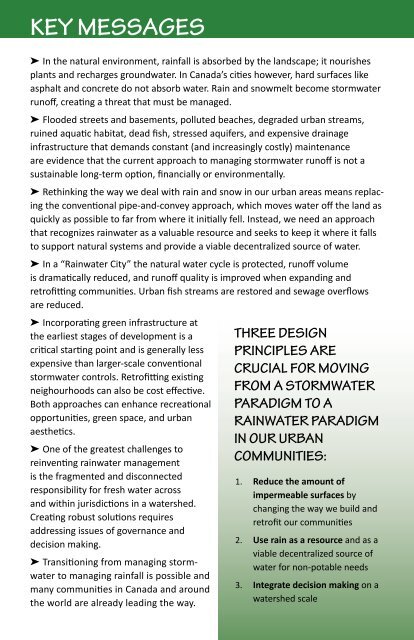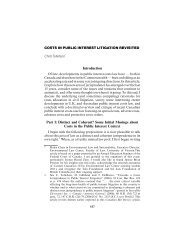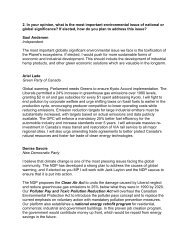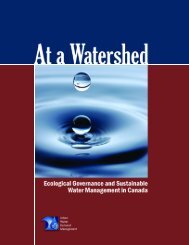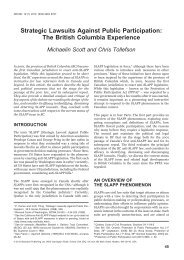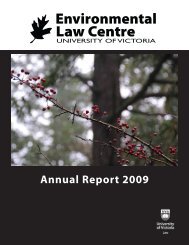Peeling back the Pavement - POLIS Water Sustainability Project
Peeling back the Pavement - POLIS Water Sustainability Project
Peeling back the Pavement - POLIS Water Sustainability Project
You also want an ePaper? Increase the reach of your titles
YUMPU automatically turns print PDFs into web optimized ePapers that Google loves.
Key messages<br />
➤ In <strong>the</strong> natural environment, rainfall is absorbed by <strong>the</strong> landscape; it nourishes<br />
plants and recharges groundwater. In Canada’s cities however, hard surfaces like<br />
asphalt and concrete do not absorb water. Rain and snowmelt become stormwater<br />
runoff, creating a threat that must be managed.<br />
➤ Flooded streets and basements, polluted beaches, degraded urban streams,<br />
ruined aquatic habitat, dead fish, stressed aquifers, and expensive drainage<br />
infrastructure that demands constant (and increasingly costly) maintenance<br />
are evidence that <strong>the</strong> current approach to managing stormwater runoff is not a<br />
sustainable long-term option, financially or environmentally.<br />
➤ Rethinking <strong>the</strong> way we deal with rain and snow in our urban areas means replacing<br />
<strong>the</strong> conventional pipe-and-convey approach, which moves water off <strong>the</strong> land as<br />
quickly as possible to far from where it initially fell. Instead, we need an approach<br />
that recognizes rainwater as a valuable resource and seeks to keep it where it falls<br />
to support natural systems and provide a viable decentralized source of water.<br />
➤ In a “Rainwater City” <strong>the</strong> natural water cycle is protected, runoff volume<br />
is dramatically reduced, and runoff quality is improved when expanding and<br />
retrofitting communities. Urban fish streams are restored and sewage overflows<br />
are reduced.<br />
➤ Incorporating green infrastructure at<br />
<strong>the</strong> earliest stages of development is a<br />
critical starting point and is generally less<br />
expensive than larger-scale conventional<br />
stormwater controls. Retrofitting existing<br />
neighourhoods can also be cost effective.<br />
Both approaches can enhance recreational<br />
opportunities, green space, and urban<br />
aes<strong>the</strong>tics.<br />
➤ One of <strong>the</strong> greatest challenges to<br />
reinventing rainwater management<br />
is <strong>the</strong> fragmented and disconnected<br />
responsibility for fresh water across<br />
and within jurisdictions in a watershed.<br />
Creating robust solutions requires<br />
addressing issues of governance and<br />
decision making.<br />
➤ Transitioning from managing stormwater<br />
to managing rainfall is possible and<br />
many communities in Canada and around<br />
<strong>the</strong> world are already leading <strong>the</strong> way.<br />
Three design<br />
principles are<br />
crucial for moving<br />
from a stormwater<br />
paradigm to a<br />
rainwater paradigm<br />
in our urban<br />
communities:<br />
1. Reduce <strong>the</strong> amount of<br />
impermeable surfaces by<br />
changing <strong>the</strong> way we build and<br />
retrofit our communities<br />
2. Use rain as a resource and as a<br />
viable decentralized source of<br />
water for non-potable needs<br />
Integrate decision making<br />
3. on a<br />
watershed scale


